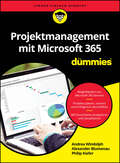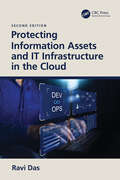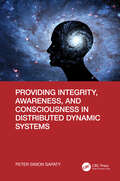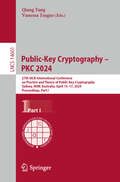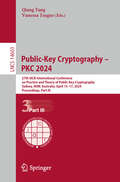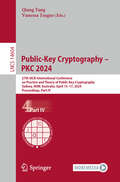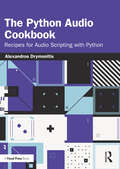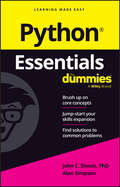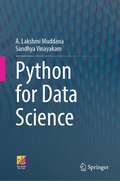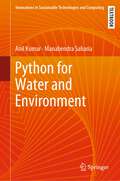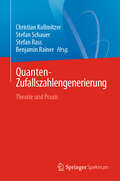- Table View
- List View
Project Management in Cloud Applications
by Pramod Chandra Bhatt Naresh Kumar SehgalCloud Computing has been in use for several decades now, but the art and science of delivering Cloud based products is still shrouded in mystery. This book shines new light on how to deliver projects on time and within budget. The authors discuss the theory and practices of software engineering as applied to successful project execution, with real, Cloud-based products.
Projektmanagement mit Microsoft 365 für Dummies (Für Dummies)
by Andrea Windolph Alexander Blumenau Philip KieferSchritt für Schritt zum erfolgreichen Projekt In diesem Buch erfahren Sie, wie die Funktionen von Excel und weiteren Microsoft-365-Programmen Sie beim Initiieren, Planen und Überwachen von Projekten unterstützen. Von der Risikoanalyse bis zu Prognoserechnungen: Lernen Sie typische Projektmanagement-Methoden kennen und erfahren Sie insbesondere, wie Sie Informationen und Daten mit Excel aufbereiten, ansprechend visualisieren und anschließend vor Auftraggeber und Team präsentieren. Auch die Verwaltung von Aufgaben sowie die digitale Zusammenarbeit mithilfe von OneDrive und Microsoft Teams kommen nicht zu kurz. Sie erfahren Wie Sie Termine, Ressourcen und Kosten planen Wie Sie Fortschritte messen, Berichte erstellen und den Projektabschluss gestalten Welche Microsoft-365-Tools die Zusammenarbeit bei Projekten erleichtern Wie Sie Daten ansprechend visualisieren
Protecting Information Assets and IT Infrastructure in the Cloud
by Ravi DasThis book is a second edition. The last one reviewed the evolution of the Cloud, important Cloud concepts and terminology, and the threats that are posed on a daily basis to it. A deep dive into the components of Microsoft Azure were also provided, as well as risk mitigation strategies, and protecting data that resides in a Cloud environment. In this second edition, we extend this knowledge gained to discuss the concepts of Microsoft Azure. We also examine how Microsoft is playing a huge role in artificial intelligence and machine learning with its relationship with OpenAI. An overview into ChatGPT is also provided, along with a very serious discussion of the social implications for artificial intelligence.
Protecting Information Assets and IT Infrastructure in the Cloud
by Ravi DasThis book is a second edition. The last one reviewed the evolution of the Cloud, important Cloud concepts and terminology, and the threats that are posed on a daily basis to it. A deep dive into the components of Microsoft Azure were also provided, as well as risk mitigation strategies, and protecting data that resides in a Cloud environment. In this second edition, we extend this knowledge gained to discuss the concepts of Microsoft Azure. We also examine how Microsoft is playing a huge role in artificial intelligence and machine learning with its relationship with OpenAI. An overview into ChatGPT is also provided, along with a very serious discussion of the social implications for artificial intelligence.
Providing Integrity, Awareness, and Consciousness in Distributed Dynamic Systems
by Peter Simon SapatyThe ideas of this book originate from the mobile WAVE approach which allowed us, more than a half century ago, to implement citywide heterogeneous computer networks and solve distributed problems on them well before the internet. The invented paradigm evolved into Spatial Grasp Technology and resulted in a European patent and eight books. The volumes covered concrete applications in graph and network theory, defense and social systems, crisis management, simulation of global viruses, gestalt theory, collective robotics, space research, and related concepts. The obtained solutions often exhibited high system qualities like global integrity, distributed awareness, and even consciousness. This current book takes these important characteristics as primary research objectives, together with the theory of patterns covering them all. This book is oriented towards system scientists, application programmers, industry managers, defense and security commanders, and university students (especially those interested in advanced MSc and PhD projects on distributed system management), as well as philosophers, psychologists, and United Nations personnel.
Providing Integrity, Awareness, and Consciousness in Distributed Dynamic Systems
by Peter Simon SapatyThe ideas of this book originate from the mobile WAVE approach which allowed us, more than a half century ago, to implement citywide heterogeneous computer networks and solve distributed problems on them well before the internet. The invented paradigm evolved into Spatial Grasp Technology and resulted in a European patent and eight books. The volumes covered concrete applications in graph and network theory, defense and social systems, crisis management, simulation of global viruses, gestalt theory, collective robotics, space research, and related concepts. The obtained solutions often exhibited high system qualities like global integrity, distributed awareness, and even consciousness. This current book takes these important characteristics as primary research objectives, together with the theory of patterns covering them all. This book is oriented towards system scientists, application programmers, industry managers, defense and security commanders, and university students (especially those interested in advanced MSc and PhD projects on distributed system management), as well as philosophers, psychologists, and United Nations personnel.
Public-Key Cryptography – PKC 2024: 27th IACR International Conference on Practice and Theory of Public-Key Cryptography, Sydney, NSW, Australia, April 15–17, 2024, Proceedings, Part I (Lecture Notes in Computer Science #14601)
by Qiang Tang Vanessa TeagueThe four-volume proceedings set LNCS 14601-14604 constitutes the refereed proceedings of the 27th IACR International Conference on Practice and Theory of Public Key Cryptography, PKC 2024, held in Sydney, NSW, Australia, April 15–17, 2024. The 54 papers included in these proceedings were carefully reviewed and selected from 176 submissions. They focus on all aspects of signatures; attacks; commitments; multiparty computation; zero knowledge proofs; theoretical foundations; isogenies and applications; lattices and applications; Diffie Hellman and applications; encryption; homomorphic encryption; and implementation.
Public-Key Cryptography – PKC 2024: 27th IACR International Conference on Practice and Theory of Public-Key Cryptography, Sydney, NSW, Australia, April 15–17, 2024, Proceedings, Part III (Lecture Notes in Computer Science #14603)
by Qiang Tang Vanessa TeagueThe four-volume proceedings set LNCS 14601-14604 constitutes the refereed proceedings of the 27th IACR International Conference on Practice and Theory of Public Key Cryptography, PKC 2024, held in Sydney, NSW, Australia, April 15–17, 2024. The 54 papers included in these proceedings were carefully reviewed and selected from 176 submissions. They focus on all aspects of signatures; attacks; commitments; multiparty computation; zero knowledge proofs; theoretical foundations; isogenies and applications; lattices and applications; Diffie Hellman and applications; encryption; homomorphic encryption; and implementation.
Public-Key Cryptography – PKC 2024: 27th IACR International Conference on Practice and Theory of Public-Key Cryptography, Sydney, NSW, Australia, April 15–17, 2024, Proceedings, Part IV (Lecture Notes in Computer Science #14604)
by Qiang Tang Vanessa TeagueThe four-volume proceedings set LNCS 14601-14604 constitutes the refereed proceedings of the 27th IACR International Conference on Practice and Theory of Public Key Cryptography, PKC 2024, held in Sydney, NSW, Australia, April 15–17, 2024. The 54 papers included in these proceedings were carefully reviewed and selected from 176 submissions. They focus on all aspects of signatures; attacks; commitments; multiparty computation; zero knowledge proofs; theoretical foundations; isogenies and applications; lattices and applications; Diffie Hellman and applications; encryption; homomorphic encryption; and implementation.
Public-Key Cryptography – PKC 2024: 27th IACR International Conference on Practice and Theory of Public-Key Cryptography, Sydney, NSW, Australia, April 15–17, 2024, Proceedings, Part II (Lecture Notes in Computer Science #14602)
by Qiang Tang Vanessa TeagueThe four-volume proceedings set LNCS 14601-14604 constitutes the refereed proceedings of the 27th IACR International Conference on Practice and Theory of Public Key Cryptography, PKC 2024, held in Sydney, NSW, Australia, April 15–17, 2024. The 54 papers included in these proceedings were carefully reviewed and selected from 176 submissions. They focus on all aspects of signatures; attacks; commitments; multiparty computation; zero knowledge proofs; theoretical foundations; isogenies and applications; lattices and applications; Diffie Hellman and applications; encryption; homomorphic encryption; and implementation.
Python All-in-One For Dummies
by John C. Shovic Alan SimpsonEverything you need to know to get into Python coding, with 7 books in one Python All-in-One For Dummies is your one-stop source for answers to all your Python questions. From creating apps to building complex web sites to sorting big data, Python provides a way to get the work done. This book is great as a starting point for those new to coding, and it also makes a perfect reference for experienced coders looking for more than the basics. Apply your Python skills to data analysis, learn to write AI-assisted code using GitHub CoPilot, and discover many more exciting uses for this top programming language. Get started coding in Python—even if you’re new to computer programming Reference all the essentials and the latest updates, so your code is air-tight Learn how Python can be a solution for large-scale projects and big datasets Accelerate your career path with this comprehensive guide to learning PythonExperienced and would-be coders alike will love this easy-to-follow guide to learning and applying Python.
Python All-in-One For Dummies
by John C. Shovic Alan SimpsonEverything you need to know to get into Python coding, with 7 books in one Python All-in-One For Dummies is your one-stop source for answers to all your Python questions. From creating apps to building complex web sites to sorting big data, Python provides a way to get the work done. This book is great as a starting point for those new to coding, and it also makes a perfect reference for experienced coders looking for more than the basics. Apply your Python skills to data analysis, learn to write AI-assisted code using GitHub CoPilot, and discover many more exciting uses for this top programming language. Get started coding in Python—even if you’re new to computer programming Reference all the essentials and the latest updates, so your code is air-tight Learn how Python can be a solution for large-scale projects and big datasets Accelerate your career path with this comprehensive guide to learning PythonExperienced and would-be coders alike will love this easy-to-follow guide to learning and applying Python.
The Python Audio Cookbook: Recipes for Audio Scripting with Python
by Alexandros DrymonitisThe Python Audio Cookbook offers an introduction to Python for sound and multimedia applications, with chapters that cover writing your first Python programs, controlling Pyo with physical computing, and writing your own GUI, among many other topics.Guiding the reader through a variety of audio synthesis techniques, the book empowers readers to combine their projects with popular platforms, from the Arduino to Twitter, and state-of-the-art practices such as AI. The Python Audio Cookbook balances accessible explanations for theoretical concepts, including Python syntax, audio processing and machine learning, with practical applications. This book is an essential introductory guide to Python for sound and multimedia practitioners, as well as programmers interested in audio applications.
The Python Audio Cookbook: Recipes for Audio Scripting with Python
by Alexandros DrymonitisThe Python Audio Cookbook offers an introduction to Python for sound and multimedia applications, with chapters that cover writing your first Python programs, controlling Pyo with physical computing, and writing your own GUI, among many other topics. Guiding the reader through a variety of audio synthesis techniques, the book empowers readers to combine their projects with popular platforms, from the Arduino to Twitter, and state-of-the-art practices such as AI. The Python Audio Cookbook balances accessible explanations for theoretical concepts, including Python syntax, audio processing and machine learning, with practical applications. This book is an essential introductory guide to Python for sound and multimedia practitioners, as well as programmers interested in audio applications.
Python Debugging for AI, Machine Learning, and Cloud Computing: A Pattern-Oriented Approach
by Dmitry VostokovThis book is for those who wish to understand how Python debugging is and can be used to develop robust and reliable AI, machine learning, and cloud computing software. It will teach you a novel pattern-oriented approach to diagnose and debug abnormal software structure and behavior. The book begins with an introduction to the pattern-oriented software diagnostics and debugging process that, before performing Python debugging, diagnoses problems in various software artifacts such as memory dumps, traces, and logs. Next, you’ll learn to use various debugging patterns through Python case studies that model abnormal software behavior. You’ll also be exposed to Python debugging techniques specific to cloud native and machine learning environments and explore how recent advances in AI/ML can help in Python debugging. Over the course of the book, case studies will show you how to resolve issues around environmental problems, crashes, hangs, resource spikes, leaks, and performance degradation. This includes tracing, logging, and analyzing memory dumps using native WinDbg and GDB debuggers. Upon completing this book, you will have the knowledge and tools needed to employ Python debugging in the development of AI, machine learning, and cloud computing applications. What You Will Learn Employ a pattern-oriented approach to Python debugging that starts with diagnostics of common software problemsUse tips and tricks to get the most out of popular IDEs, notebooks, and command-line Python debuggingUnderstand Python internals for interfacing with operating systems and external modulesPerform Python memory dump analysis, tracing, and logging Who This Book Is For Software developers, AI/ML engineers, researchers, data engineers, as well as MLOps and DevOps professionals.
Python Essentials For Dummies
by John C. Shovic Alan SimpsonThe no-nonsense way to get started coding in the Python programming language Python Essentials For Dummies is a quick reference to all the core concepts in Python, the multifaceted general-purpose language used for everything from building websites to creating apps. This book gets right to the point, with no excess review, wordy explanations, or fluff, making it perfect as a desk reference on the job or as a brush-up as you expand your skills in related areas. Focusing on just the essential topics you need to know to brush up or level up your Python skill, this is the reliable little book you can always turn to for answers. Get a quick and thorough intro to the basic concepts of coding in Python Review what you've already learned or pick up essential new skills Create websites, software, machine learning, and automation for school or work Keep this concise reference book handy for jogging your memory as you code This portable Dummies Essentials book focuses on the key topics you need to know about the popular Python language. Great for supplementing a course, reviewing for a certification, or staying knowledgeable on the job.
Python Essentials For Dummies
by John C. Shovic Alan SimpsonThe no-nonsense way to get started coding in the Python programming language Python Essentials For Dummies is a quick reference to all the core concepts in Python, the multifaceted general-purpose language used for everything from building websites to creating apps. This book gets right to the point, with no excess review, wordy explanations, or fluff, making it perfect as a desk reference on the job or as a brush-up as you expand your skills in related areas. Focusing on just the essential topics you need to know to brush up or level up your Python skill, this is the reliable little book you can always turn to for answers. Get a quick and thorough intro to the basic concepts of coding in Python Review what you've already learned or pick up essential new skills Create websites, software, machine learning, and automation for school or work Keep this concise reference book handy for jogging your memory as you code This portable Dummies Essentials book focuses on the key topics you need to know about the popular Python language. Great for supplementing a course, reviewing for a certification, or staying knowledgeable on the job.
Python for Data Science
by A. Lakshmi Muddana Sandhya VinayakamThe book is designed to serve as a textbook for courses offered to undergraduate and graduate students enrolled in data science. This book aims to help the readers understand the basic and advanced concepts for developing simple programs and the fundamentals required for building machine learning models. The book covers basic concepts like data types, operators, and statements that enable the reader to solve simple problems. As functions are the core of any programming, a detailed illustration of defining & invoking functions and recursive functions is covered. Built-in data structures of Python, such as strings, lists, tuples, sets, and dictionary structures, are discussed in detail with examples and exercise problems. Files are an integrated part of programming when dealing with large data. File handling operations are illustrated with examples and a case study at the end of the chapter. Widely used Python packages for data science, such as Pandas, Data Visualization libraries, and regular expressions, are discussed with examples and case studies at the end of the chapters. The book also contains a chapter on SQLite3, a small relational database management system of Python, to understand how to create and manage databases. As AI applications are becoming popular for developing intelligent solutions to various problems, the book includes chapters on Machine Learning and Deep Learning. They cover the basic concepts, example applications, and case studies using popular frameworks such as SKLearn and Keras on public datasets
Python for Data Science For Dummies
by John Paul Mueller Luca MassaronLet Python do the heavy lifting for you as you analyze large datasets Python for Data Science For Dummies lets you get your hands dirty with data using one of the top programming languages. This beginner’s guide takes you step by step through getting started, performing data analysis, understanding datasets and example code, working with Google Colab, sampling data, and beyond. Coding your data analysis tasks will make your life easier, make you more in-demand as an employee, and open the door to valuable knowledge and insights. This new edition is updated for the latest version of Python and includes current, relevant data examples. Get a firm background in the basics of Python coding for data analysis Learn about data science careers you can pursue with Python coding skills Integrate data analysis with multimedia and graphics Manage and organize data with cloud-based relational databasesPython careers are on the rise. Grab this user-friendly Dummies guide and gain the programming skills you need to become a data pro.
Python for Data Science For Dummies
by John Paul Mueller Luca MassaronLet Python do the heavy lifting for you as you analyze large datasets Python for Data Science For Dummies lets you get your hands dirty with data using one of the top programming languages. This beginner’s guide takes you step by step through getting started, performing data analysis, understanding datasets and example code, working with Google Colab, sampling data, and beyond. Coding your data analysis tasks will make your life easier, make you more in-demand as an employee, and open the door to valuable knowledge and insights. This new edition is updated for the latest version of Python and includes current, relevant data examples. Get a firm background in the basics of Python coding for data analysis Learn about data science careers you can pursue with Python coding skills Integrate data analysis with multimedia and graphics Manage and organize data with cloud-based relational databasesPython careers are on the rise. Grab this user-friendly Dummies guide and gain the programming skills you need to become a data pro.
Python for Teenagers: Learn to Program like a Superhero!
by James R. PayneThis book, which is designed for middle-school through college-aged students, will arm beginners with solid programming foundations they can carry throughout life. It uses fun and simple language (and programming examples) to teach the fundamentals needed to start the down path of becoming a programmer. Python is a highly flexible language, allowing developers to enter any number of technical fields and is a welcome addition to any resume. With its low learning curve, it makes a great introductory language, as new developers can take the coding fundamentals they learn in Python and apply them to any other language. The second edition builds upon the foundation of the first book, revising all the chapters where the language has changed, updating the commands, code, and examples to bring it up to date with the current version of Python. Since Python is the most popular programming language in the world and can be used in conjunction with other languages - across multiple platforms - it can increase the reader's ability to qualify for a wider range of jobs than other languages. Finally, Python is fun - something not every programming language can boast! What You Will Learn Install and configure PythonGrasp basic software development principles and syntaxUnderstand the best practices for coding in PythonCreate applications and debug code Who This Book Is For The book’s target audience is primarily middle school to college aged students looking to learn how to program computers and develop software. Older individuals and computer programmers who know other languages and want to add Python to their repertoire can also benefit from the book.
Python for Water and Environment (Innovations in Sustainable Technologies and Computing)
by Anil Kumar Manabendra SahariaThis textbook delves into the practical applications of surface and groundwater hydrology, as well as the environment. The Part I, "Practical Python for a Water and Environment Professional," guides readers through setting up a scientific computing environment and conducting exploratory data analysis and visualization using reproducible workflows. The Part II, "Statistical Modeling in Hydrology," covers regression models, time series analysis, and common hypothesis testing. The Part III, "Surface and Subsurface Water," illustrates the use of Python in understanding key concepts related to seepage, groundwater, and surface water flows. Lastly, the Part IV, "Environmental Applications," demonstrates the application of Python in the study of various contaminant transport phenomena.
Python Programming for Linguistics and Digital Humanities: Applications for Text-Focused Fields
by Martin WeisserLearn how to use Python for linguistics and digital humanities research, perfect for students working with Python for the first time Python programming is no longer only for computer science students; it is now an essential skill in linguistics, the digital humanities (DH), and social science programs that involve text analytics. Python Programming for Linguistics and Digital Humanities provides a comprehensive introduction to this widely used programming language, offering guidance on using Python to perform various processing and analysis techniques on text. Assuming no prior knowledge of programming, this student-friendly guide covers essential topics and concepts such as installing Python, using the command line, working with strings, writing modular code, designing a simple graphical user interface (GUI), annotating language data in XML and TEI, creating basic visualizations, and more. This invaluable text explains the basic tools students will need to perform their own research projects and tackle various data analysis problems. Throughout the book, hands-on exercises provide students with the opportunity to apply concepts to particular questions or projects in processing textual data and solving language-related issues. Each chapter concludes with a detailed discussion of the code applied, possible alternatives, and potential pitfalls or error messages. Teaches students how to use Python to tackle the types of problems they will encounter in linguistics and the digital humanities Features numerous practical examples of language analysis, gradually moving from simple concepts and programs to more complex projects Describes how to build a variety of data visualizations, such as frequency plots and word clouds Focuses on the text processing applications of Python, including creating word and frequency lists, recognizing linguistic patterns, and processing words for morphological analysis Includes access to a companion website with all Python programs produced in the chapter exercises and additional Python programming resourcesPython Programming for Linguistics and Digital Humanities: Applications for Text-Focused Fields is a must-have resource for students pursuing text-based research in the humanities, the social sciences, and all subfields of linguistics, particularly computational linguistics and corpus linguistics.
Python Programming for Linguistics and Digital Humanities: Applications for Text-Focused Fields
by Martin WeisserLearn how to use Python for linguistics and digital humanities research, perfect for students working with Python for the first time Python programming is no longer only for computer science students; it is now an essential skill in linguistics, the digital humanities (DH), and social science programs that involve text analytics. Python Programming for Linguistics and Digital Humanities provides a comprehensive introduction to this widely used programming language, offering guidance on using Python to perform various processing and analysis techniques on text. Assuming no prior knowledge of programming, this student-friendly guide covers essential topics and concepts such as installing Python, using the command line, working with strings, writing modular code, designing a simple graphical user interface (GUI), annotating language data in XML and TEI, creating basic visualizations, and more. This invaluable text explains the basic tools students will need to perform their own research projects and tackle various data analysis problems. Throughout the book, hands-on exercises provide students with the opportunity to apply concepts to particular questions or projects in processing textual data and solving language-related issues. Each chapter concludes with a detailed discussion of the code applied, possible alternatives, and potential pitfalls or error messages. Teaches students how to use Python to tackle the types of problems they will encounter in linguistics and the digital humanities Features numerous practical examples of language analysis, gradually moving from simple concepts and programs to more complex projects Describes how to build a variety of data visualizations, such as frequency plots and word clouds Focuses on the text processing applications of Python, including creating word and frequency lists, recognizing linguistic patterns, and processing words for morphological analysis Includes access to a companion website with all Python programs produced in the chapter exercises and additional Python programming resourcesPython Programming for Linguistics and Digital Humanities: Applications for Text-Focused Fields is a must-have resource for students pursuing text-based research in the humanities, the social sciences, and all subfields of linguistics, particularly computational linguistics and corpus linguistics.
Quanten-Zufallszahlengenerierung: Theorie und Praxis
by Stefan Rass Stefan Schauer Christian Kollmitzer Benjamin RainerDieses Buch bietet einen Überblick über die neuesten Implementierungen von Quanten-Zufallszahlengeneratoren (QRNGs) und untersucht insbesondere deren Beziehung zu klassischen statistischen Zufallsmodellen und numerischen Techniken zur Berechnung von Zufallszahlen. Der Leser - der idealerweise einen Hintergrund in klassischer Statistik, Informatik oder Kryptographie hat - wird Schritt für Schritt in die Welt der Quantenbits eingeführt, und es werden explizite Beziehungen zwischen QRNGs und ihren klassischen Gegenstücken aufgezeigt. Die Erzeugung von Zufallszahlen ist eine wichtige Säule der Kryptographie. Die Nutzung des Zufalls, der Quantenphänomenen innewohnt, ist ein sich rasch entwickelnder Zweig der Quantenkryptografie mit unzähligen Anwendungen für die Zukunft. Der Wert der Quantenzufälligkeit für kryptografische Zwecke wird empirisch durch statistische Auswertungen der Leistung von QRNGs im Vergleich zu klassischen Techniken zur Erzeugung echter und pseudozufälliger Zahlen nachgewiesen. Das Buch bietet dann einen Überblick über die technischen Implementierungen von QRNGs, bevor eine abschließende Diskussion über die wichtigsten Errungenschaften und verbleibenden Hindernisse auf diesem Gebiet die Berichterstattung abrundet und gleichzeitig die Tür für zukünftige Forschungsrichtungen öffnet.

